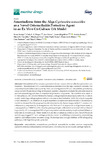Amentadione from the alga cystoseira usneoides as a novel osteoarthritis protective agent in an ex vivo co-culture OA model

View/
Use this link to cite
http://hdl.handle.net/2183/27098
Except where otherwise noted, this item's license is described as Creative Commons Attribution 4.0 International License (CC-BY 4.0)
Collections
- Investigación (FCS) [1295]
Metadata
Show full item recordTitle
Amentadione from the alga cystoseira usneoides as a novel osteoarthritis protective agent in an ex vivo co-culture OA modelAuthor(s)
Date
2020-12-07Citation
Araújo N, Viegas CSB, Zubía E, Magalhães J, Ramos A, Carvalho MM, Cruz H, Sousa JP, Blanco FJ, Vermeer C, Simes DC. Amentadione from the alga cystoseira usneoides as a novel osteoarthritis protective agent in an ex vivo co-culture OA model. Mar Drugs. 2020 Dec 7;18(12):624.
Abstract
[Abstract] Osteoarthritis (OA) remains a prevalent chronic disease without effective prevention and treatment. Amentadione (YP), a meroditerpenoid purified from the alga Cystoseira usneoides, has demonstrated anti-inflammatory activity. Here, we investigated the YP anti-osteoarthritic potential, by using a novel OA preclinical drug development pipeline designed to evaluate the anti-inflammatory and anti-mineralizing activities of potential OA-protective compounds. The workflow was based on in vitro primary cell cultures followed by human cartilage explants assays and a new OA co-culture model, combining cartilage explants with synoviocytes under interleukin-1β (IL-1β) or hydroxyapatite (HAP) stimulation. A combination of gene expression analysis and measurement of inflammatory mediators showed that the proposed model mimicked early disease stages, while YP counteracted inflammatory responses by downregulation of COX-2 and IL-6, improved cartilage homeostasis by downregulation of MMP3 and the chondrocytes hypertrophic differentiation factors Col10 and Runx2. Importantly, YP downregulated NF-κB gene expression and decreased phosphorylated IkBα/total IkBα ratio in chondrocytes. These results indicate the co-culture as a relevant pre-clinical OA model, and strongly suggest YP as a cartilage protective factor by inhibiting inflammatory, mineralizing, catabolic and differentiation processes during OA development, through inhibition of NF-κB signaling pathways, with high therapeutic potential.
Keywords
Osteoarthritis
Amentadione
Preclinical osteoarthritis models
Marine compounds
Cystoseira usneoides
Inflammation
Mineralization
Chondrocytes
Synoviocytes
Cartilage explants
Amentadione
Preclinical osteoarthritis models
Marine compounds
Cystoseira usneoides
Inflammation
Mineralization
Chondrocytes
Synoviocytes
Cartilage explants
Editor version
Rights
Creative Commons Attribution 4.0 International License (CC-BY 4.0)
ISSN
1660-3397






